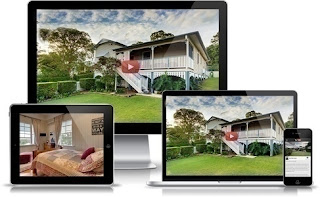 Using video marketing is becoming a pivotal marketing tool in
real estate business. Your video tours of listings should be more than a series
of property pictures that zoom in or out.
Using video marketing is becoming a pivotal marketing tool in
real estate business. Your video tours of listings should be more than a series
of property pictures that zoom in or out.
When it comes to recording videos, there's plenty of good
news there: High-definition (HD) video recording is now a standard feature of
camcorders, digital cameras, and a growing selection of smartphones, making it
easy to convey the appeal of properties in movies.
It worth mentioning that recording quality alone does not
make a compelling presentation. Building a video tour is a creative challenge
that requires combination of skills and resources, beyond the lens. With a
little forethought and practice, you can tap this medium's potential and make
it into one of the most effective marketing resources at your disposal.
Let's look at other considerations that should guide your
videography efforts. Here are a few ways you can make your movies a polished
preview of a property.
1) Plan
ahead.
A video tour is a virtual walk-through. For buyers, a
well-made video tour is probably the next best thing to being there. For
sellers, it's a demonstration you're a marketing expert.
You can minimize the work and production time by thinking
things through before you hit the record button. I encourage you to map out a
storyboard of how you'll move through the house, which features you want to
highlight, and what you'll say as you move from room to room.
Decide before you start filming which shots; and from what
angles will give viewers a realistic idea of that space. Think about where
you'll need to add more lighting or draw the blinds. For your first few tours,
the better you plan ahead, the more time you'll save and the more professional
the results will be. After several video tours, the recording process will
become almost intuitive.
2)
Extras.
When you want to pan the exterior or capture an entire room,
a tripod ensures a steady image. Mount that to some type of dolly, and you can
make a smooth transition from room to room as you lead viewers through the
home.
Depending on your camera, you may also want to pack an
accessory wide-angle lens adapter. Also, although many cameras will record
serviceable video even in dimly lit interiors, extra lighting will always
improve the results.
3)
Editing software.
After recording your video you will need to do some editing
to your marketing material. Look first at the editing software included with
your device, then at the software available for your
computer: MovieMaker for Windows and iMovie for Macs.
If you want more advanced features, you'll have to pay more.
You can get professional, fully loaded editing software such as Final Cut
Pro X, Sony Vegas Pro, and Adobe Premiere Pro.
4) Audio.
The video is what they see, but audio helps tell the story.
Use background music; maybe something generic and preferably royalty-free to
set the mood. A spoken narrative presents an opportunity to introduce yourself
as you talk up the listing and its surroundings.
Get the video right first, and then add voiceover narration
as you watch the clip and describe what you're showing. Allow as many takes as
required to explain what's special about this listing, as if you were guiding
them through the home.
5) Hosting
and syndication.
When you have done all the work and your video is ready to be
uploaded to the internet, you'll need a hosting account for your video to be
available online. YouTube is probably the first option that comes to
mind, but there are many others as: Vimeo and Yahoo Video.
Also, with TubeMogul's free OneLoad service, you can
upload and distribute videos to a range of popular hosting and social
networking sites in a few steps.
Remember, too, today's buyers are just as likely to access
the Web from a smartphone or tablet as a PC. You want to be sure that your
video is properly formatted for viewing, whatever the device is.
6) Links
and widgets.
Take advantage of the links and widgets that hosting sites
offer so you can highlight your tours on your Web site and property pages. Use
widgets to create a window for viewing your tours without leaving your site. Your real
estate video is one of the most powerful tools available in real estate
marketing. Take every opportunity to let the world know you're using it. Point
visitors to your YouTube channel and video tours on flyers and mailings, and
talk up your use of video throughout your web site.
Go one step further by creating QR codes for your
video tours and make them a fixture of yard signs and flyers. Many smartphone
owners won't be able to resist the opportunity to scan that code to instantly
view the video.
Even if they decide they're not interested in that home, your use of these tools might convince them you're the most qualified
real estate professional to represent their interests.
No comments:
Post a Comment